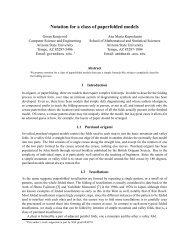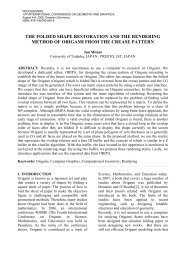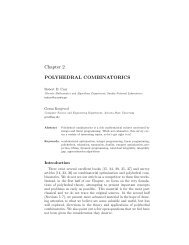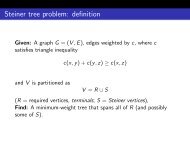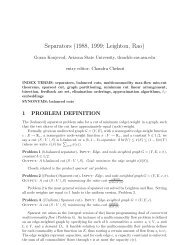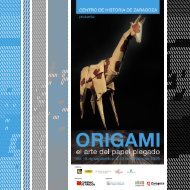POETRY IN PAPER POEZIJA U PAPIRU - Organic Origami
POETRY IN PAPER POEZIJA U PAPIRU - Organic Origami
POETRY IN PAPER POEZIJA U PAPIRU - Organic Origami
You also want an ePaper? Increase the reach of your titles
YUMPU automatically turns print PDFs into web optimized ePapers that Google loves.
Muzej za umjetnost i obrt u Hamburgu; Muzej Mingei u<br />
San Diegu; Louvre u Parizu; te kao dio upravo zatvorene<br />
izložbe ‘Dizajn i elastični um’ u Muzeju moderne umjetnosti<br />
MoMA, New York). Beziznimno začuđuje velika posjećenost<br />
tih događanja i entuzijazam posjetitelja. Ova tema<br />
privlači sve dobne skupine i društvene klase. Zašto je<br />
origami uspješan tamo gdje se ostala suvremena umjetnost<br />
probija? Pa origami stvarno i jest drugačiji. Može biti suvremen<br />
(većina njegovih vodećih imena je još uvijek živuća) ali<br />
nije uperen protiv tradicije, jer duboko poštuje svoje porijeklo<br />
staro stotinama godina. Ne podcjenjuje niti<br />
rukotvorine, već ih naprotiv cijeni - jer je po sebi od svih<br />
rukotvorina najviše vođen upravo rukama. Ništa se ne priječi<br />
između prstiju tvorca i skulpture koja se oblikuje. Ne<br />
zadržava se na kaosu i zbrci modernog života, već svoj intelekt<br />
troši na priličan problem, kako iz kvadrata dobiti<br />
dobru zlatnu ribicu. Nema veze sa Velikim Umjetničkim<br />
Imenom, ni njegovom glamuroznošću — jer je ono do<br />
čeg mu je stalo običan papir, pa odatle i veza sa<br />
običnim ljudima. A to je ono što privlači mase.<br />
Jer sve što origami čini, jest malo čarobno<br />
nešto gotovo ni iz čega. To je još uvijek<br />
"samo list papira", ali sada s dovoljno<br />
genija, geometrije i duha da vam<br />
izmami osmijeh.<br />
Peabody-Essex museum near Boston; the Tikotin Museum<br />
of Japanese Art in Haifa; the Pendulum Gallery in Vancouver;<br />
Hangar-7 in Salzburg; the Museum fur Kunst und<br />
Gewerbe in Hamburg; the Mingei Museum in San Diego;<br />
the Louvre in Paris; and as part of the just-closed ‘Design<br />
and the Elastic Mind’ exhibit at MoMA, New York). Invariably<br />
there is surprise at the vastly increased attendance<br />
rates these shows bring, and at the enthusiasm of the visitors.<br />
All age groups and social classes seem to be drawn to<br />
this subject. Why is origami successful were the other contemporary<br />
arts are struggling? Well, but origami really is different.<br />
It may be contemporary (most of its leading figures<br />
are still alive today) but it is not anti-traditional, for it has a<br />
deep respect for its centuries-old origins. It does not disparage<br />
handicraft either, but rather values it—for it itself is the<br />
most ‘handy’ of crafts, nothing coming between the makers<br />
finger’s and the sculpture being formed. It does not dwell<br />
on the chaos and disorder of modern life, but expends<br />
its intellect on the considerable problem of making<br />
a good goldfish out of a square. It has nothing<br />
to do with the Big Name Artist or his<br />
glamour — for what it cares about is<br />
ordinary paper, and through it, the<br />
connection with ordinary people.<br />
And this is what draws<br />
the crowds. For all<br />
origami does, is make a little<br />
magical something out of<br />
almost nothing. It is still "just a<br />
sheet of paper” but now with<br />
enough genius, geometry, and spirit, to<br />
make you smile.<br />
9



